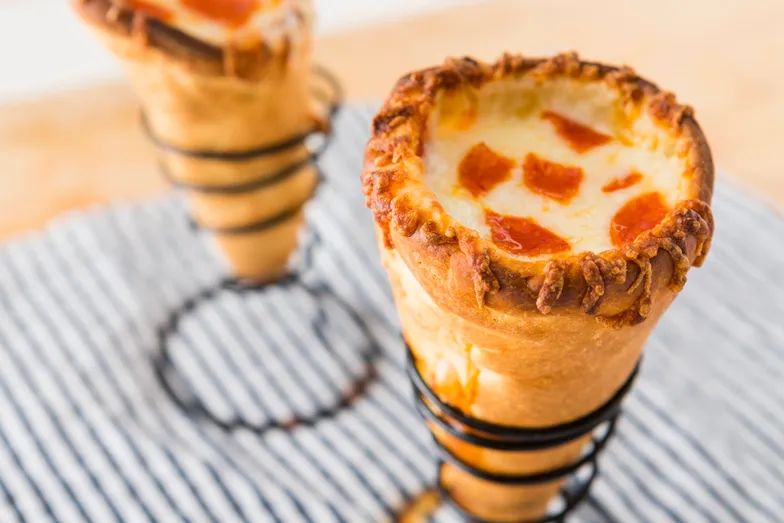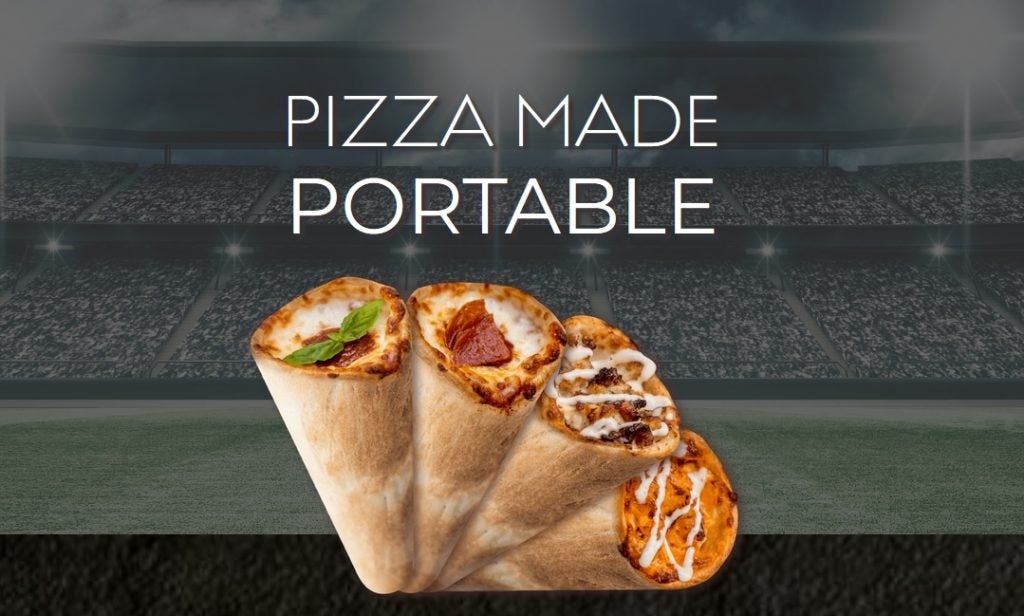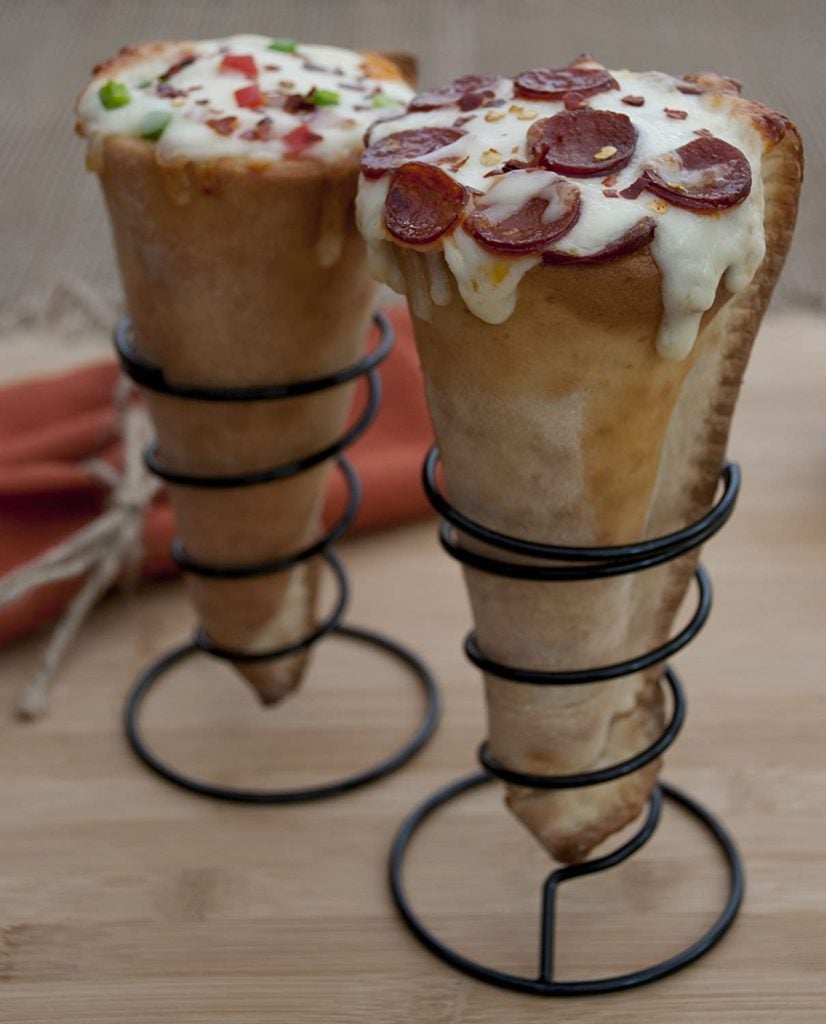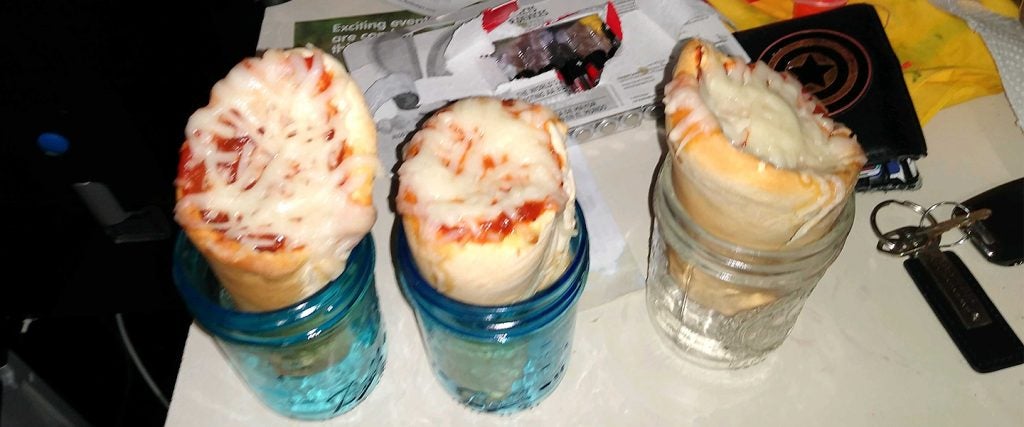A lot of people like to make rules around what pizza is and isn’t. From where a pizza is made to what toppings are on it, a pizza can be deemed illegitimate if it doesn’t meet their strict set of standards. I, however, am not a pizza purist. While I have my preferences, I think the beauty of my favorite food is that it’s highly adaptable and inclusive. This is why, when I stumbled upon something called a “pizza cone” on Reddit, I looked into it with an open mind.

If you’re unfamiliar with pizza cones, the name pretty much sums it up. It’s an ice cream cone-shaped pizza crust stuffed with sauce, cheese and whatever toppings you choose. There are a handful of different restaurants that offer pizza cones, but none in the New York Metro area where I live, so I was forced to make my own at home.
The toughest part of making them was getting my pizza dough into a cone shape. There is such a thing as a cone mold for baking, but I couldn’t find one, so I jerry-rigged my own out of tinfoil and construction paper. I then wrapped some Pillsbury Mini Pizza Crusts around the molds and baked them until they hardened. Next, I filled them with sauce, pepperoni and meatballs, topped them with cheese and put them back in the oven.
Overall, I’d say the results were just fine. The pizza cone tasted good, though it needed a bit more cheese. The recipe I found online recommended mixing the toppings in with the sauce, scooping that into a cone and then topping it with cheese, but that left me with a ton of sauce and not much cheese. Also, when I bit into it, the sauce popped out like a giant, pizza-filled gusher, getting all over me. Still, I saw potential in the pizza cone, and although I wouldn’t go through the trouble to make it again, I reasoned that if I saw one in the wild, I’d order it (especially since experienced pizza-cone makers will probably do a better job with proportioning things out than I did).
But when I did some digging into the history of pizza cones, my open-mindedness soon gave way to contempt.
I originally thought that pizza cones were a new invention, which is why I’d never heard of them before. But they went back further than I thought. I found recipes for pizza cones dating back to the 1960s and the 1980s, and there was even a patent for a pizza cone filed in 1983. Apparently, they’ve even been successful overseas. However, the first big push for pizza cones in the U.S. came in 2009.
In a news story that was syndicated nationwide, it was announced that investors and Italian inventors were teaming with an Indianapolis bakery to make pizza cones that would be sold at a South Carolina-based gelato chain. The geography of all of that may seem convoluted, but the story presented pizza cones as the next great food innovation that everyone was convinced would take America by storm. The bakery proprietor even referred to them as “the next hula hoop.”

Needless to say, pizza cones did not sweep across America. In fact, neither that bakery, nor that gelato place, have anything to do with pizza cones anymore. The woman on the phone at Pino Gelato literally said to me, “Pizza cones? I’ve never heard of that.” From what I can tell, the last time they even mentioned them online was way back in 2013.
Aside from that, a number of pizza-cone chains have come and gone in the past decade, usually following the same pattern: They arrive to much fanfare, announcing themselves as the greatest thing to happen to pizza since pepperoni, but within a few years — and sometimes far less — they close down. Now, there have been a few exceptions — a few pizza-cone establishments have lasted for more than five years — but generally speaking, pizza cones haven’t been successful.
Part of the reason why seems to be close-minded consumers. In a 2014 article from Eater hilariously titled “Foolish Restaurateurs Attempt to Peddle Pizza Cones Again,” the author chronicles the failed history of pizza cones in New York City, mostly from the perspective that it’s an abomination. However, I’d argue that the marketing behind pizza cones is the real reason for its lack of success.
Just about every time pizza cones are introduced, they promote themselves as an improvement on pizza, as though standard pizza isn’t perfect already. When Pino Gelato began selling pizza cones in 2009, the owner said, “It doesn’t spill, it doesn’t leak and you can hold it with one hand.” In 2013, the Pizza Cone Co. in Florida touted their pizza cones as the “smarter way” to consume pizza. Chanks, which makes frozen pizza cones, claims that their product is better than “sloppy, floppy slices.” They also had the slogan “Pizza Made Portable.”

Here’s the problem: Pizza is already portable! One of the reasons pizza has been so successful is that it’s a handheld food that’s easily consumed. Even larger slices are easy to eat if you just fold the crust. Once in a while, a slice is too flimsy for its toppings, but in all my pizza-eating experience — which has been very extensive — unmanageable slices are pretty rare. Also, I don’t see how a messy slice is made more convenient by replacing it with a cone that you can’t even put down! That’s right, unless you have a narrow cup holder or an ice cream cone stand nearby, you have to consume the entire pizza cone without setting it down ever — otherwise, you risk all of its ingredients spilling out.

In contrast, let’s compare the marketing of pizza cones with another pizza gimmick, Totino’s Pizza Rolls. If we take a look at Totino’s TV spots, a 1990s commercial for Pizza Rolls offered, “Great pizza taste in every little bite-sized snack.” A decade later, Totino’s promised, “Big pizza taste in a bite-sized roll.” They’re not promising to replace or revolutionize pizza, nor are they saying that one day, all pizza will be pouches filled with ambiguous orange mush. Instead, they’re just saying that if you chuck these things in a microwave, they kind of taste like pizza.
Pizza cones, however, have an approach like a cheesy infomercial. They cast traditional pizza as some notorious problem product, but, “If you dial now, pizza cones will change your life!” I even spoke to an owner of a pizza-cone franchise who told me that pizza cones are better because, “You can’t hold a beer and a slice of pizza at the same time.” While it’s true that a pizza cone and a beer can be double-fisted quite nicely — see below — I’ve drank a beer and held a slice of pizza simultaneously thousands of times in my life. It’s not that fucking hard.
The truth is, a pizza cone will never be anything more than a second-rate gimmick. They’re perfect for carnival food or food trucks, and they’d probably make for a killer appetizer at TGI Fridays, but that’s all. Pizza cone makers — and especially their marketing teams — need to understand that they’ll never replace pizza, and that traditional pizza isn’t a food that needs fixing. So, pizza-cone makers: Embrace your secondary status and make the most of it. I implore you to look at Totino’s Pizza Rolls. If you can do that, the possibilities are limitless.

